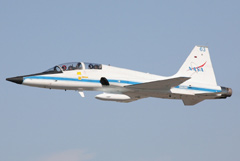
|
First Production T-38 Retires
from NASA
|
|
|
11/5/2007 - EL SEGUNDO, CA -- The first production-configuration T-38 pilot training aircraft built for the U.S. Air Force by Northrop Grumman Corporation landed today at Los Angeles International Airport (LAX) and rolled to a stop for the very last time. The sleek, white supersonic aircraft now sporting a NASA logo, a blue nose-to-tail racing stripe and tail number N963, came to rest on the tarmac outside the former LAX Imperial terminal -- now home to the Flight Path Learning Center & Museum -- where company executives, employees and aviation enthusiasts had been waiting excitedly to witness aviation history. After 46 years of serving the pilot training needs of the Air Force, the U.S. Navy and NASA, the Hawthorne, Calif.-built N963 aircraft and the oldest T-38 trainer still flying, was home. "T-38 trainers, known to pilots as the 'White Rocket,' have been in service since 1961, preparing an estimated 80,000 military pilots to fly front line fighters and bombers," said George Vardoulakis, vice president of tactical systems for F/A-18 programs for Northrop Grumman's Integrated Systems sector. "They continue to be among the safest, most reliable and highest performing supersonic aircraft in service today, a testament to Northrop Grumman's enduring strength as a first tier designer, developer, producer and maintainer of manned military aircraft." Approximately 700 of the 1187 T-38s built from 1959 to 1972 remain operational today, he added. N963, which has spent its last 16 years training NASA shuttle pilots, was officially retired earlier this spring. The company plans to put the plane on permanent static display at Integrated Systems' sector headquarters in El Segundo. The pilot for N963's final flight was Dave Finney, chief of aircraft operations for NASA's Johnson Space Center in Houston. He piloted the twin-seat, twin-engine aircraft from Houston's Ellington Field to Los Angeles with refueling stops in El Paso, Texas, and Phoenix. After shutting down the aircraft's engines for the last time, Finney raised the canopy, climbed down the T-38's built-in ladder, and saluted the crowd. He was greeted on the tarmac by Vardoulakis and Roy Martin, the chief test pilot for Northrop Grumman Integrated Systems Western Region. The NASA N963 T-38 trainer began life as an Air Force T-38 trainer with tail number 59-1603. It was among the first T-38s to roll off Northrop Grumman's aircraft assembly line in Hawthorne. The aircraft was officially delivered to the Air Force on January 31, 1961 then transferred to Edwards Air Force Base, where it participated in the final year of the T-38 flight test program. Over the next 45 years, its journey as a trainer aircraft included stops at many military installations around the country, including: 1962 -- Delivered to Randolph AFB, Texas, to serve as Air Force Training Command's primary supersonic trainer. 1964 -- Sent to Dobbins AFB, Georgia, to serve as a chase plane for newly designed aircraft. 1966 -- Transferred along with three other T-38s to Los Angeles International Airport to help train astronauts for Manned Orbiting Laboratory missions. 1969 -- Returned to Edwards AFB, Calif., to serve as a chase plane and to help maintain pilot proficiency. 1972 -- Transferred to China Lake Naval Weapons Center with the intention of making it into a drone, or unmanned target aircraft, capable of being operated by radio control. 1974 -- Entered service at Navy's Top Gun air combat training program at Miramar Naval Air Station, San Diego. In this role, T-38 and pilot mimicked Soviet fighter aircraft to help train Navy aviators in air-to-air combat techniques. 1976 -- Returned to China Lake Naval Weapons Center where its rear cockpit received drone equipment. Over the next ten years, served as an air-to-air radar target, a chase plane, and pilot proficiency plane, participating in both manned and unmanned missions. 1987 -- Transferred to Fallon Naval Air Station, Nev., to serve as a pilot proficiency aircraft. 1989 -- 1991 Transferred to NASA, then underwent complete renovation, including replacement of key structural components; installation of new wings, new landing gear, improved ejection seats and radar altimeter; significant rewiring of the cockpit and nose sections; and replacement of its canopy and windshield plastic. 1991 -- Returned to service as a trainer aircraft for NASA astronauts 2007 -- Retired from active duty and returned to Northrop Grumman for long term static display. Northrop Grumman has been producing replacement wings for T-38 trainers since the 1980s. A redesigned wing that went into production in 2006 will be used to retrofit the entire fleet. The new wing, which the company is producing in its El Segundo aircraft manufacturing facility, is expected to extend the operational life of T-38s to approximately 2040. Source: Northrop Grumman Press Release |
|
|
All original content Copyright © 2006 - 2008 The North Spin
